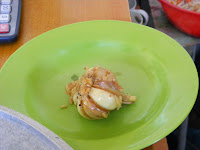 For the last cooking class, our teacher was going to help us make lagman (лагман) from scratch, noodles and all. Honestly, I had been waiting for this and fearing it all at the same time. Making homemade noodles is no joke, and as I quickly learned, perhaps more practice is necessary for me. I learned some more humility during this class.
For the last cooking class, our teacher was going to help us make lagman (лагман) from scratch, noodles and all. Honestly, I had been waiting for this and fearing it all at the same time. Making homemade noodles is no joke, and as I quickly learned, perhaps more practice is necessary for me. I learned some more humility during this class.
What is lagman? Lagman is this amazingly hearty stew with meat, vegetables, noodles (лапша) and a flavorful, spicy broth. Lagman is traditionally a Uyghur or Dungan dish. These Muslim minorities migrated from northern China to Kyrgyzstan and other parts of Central Asia. Now, lagman can been seen in Central Asia, China, and even Russia.
So if you have a couple of hours and some friends to help, I totally recommend making some lagman.
Ingredients:
Noodles
8 cups of flour
1 1/2 cups of water water
2-3 eggs
Salt
Stew
1 lb of beef or lamb (we used beef)
3 cups of broth
1 onion
1 green radish
3 carrots
2 red bell peppers (In Kyrgyzstan, they are pickled with salt, but fresh is fine as well.)
1/4 cup of tomato paste
Head of garlic, minced
Vegetable or Sunflower seed oil
Chopped parsley for garnish
For the noodles
1. In a bowl, mix the flour, water and eggs together.
2. Knead the dough until it is pliable (this will help later on). Then let it sit for 30 minutes or so.
3. Divide the dough into thick strands (see picture below). It is a good idea to oil your hands while working with the dough. Then cover the pieces in oil and let them rest for 10-15 minutes.
4. Begin to roll the dough with your palms against the table and stretch the dough. As the noodles get longer hit them against the table, it will help even out the dough. Don't for get to keep the noodles oiled as well. If a strand is not stretching well, let it rest for a while. (Don't worry if your noodles don't look nice! I questioned all my cooking abilities while doing this. I've been told it just takes practice)
5. Fold the noodles as they become longer and thinner.
6. In a pot of boil water, cook the noodles for 5 minutes. Then rinse them in cold water and cover with oil.
7. When serving, place the pasta first in your serving bowls.
For the stew
1. In the meantime, slice onion (in "half moons"), carrots (matchstick), radish (matchstick), and meat (cubed).
2. First, heat up oil in a large pot. Add the meat, garlic, and onions. Cook until meat is slightly browned.
3. Then add broth, carrots, radish, peppers, and tomato paste.
4. Let simmer for 10-15 minutes until carrots and radishes are cooked through.
For plating
Place the noodles in the bowl first, followed by the stew and parsley. If you like your lagman spicy, you can make a paste out of chili powder, red pepper, garlic, and oil to add on top. Enjoy!













































